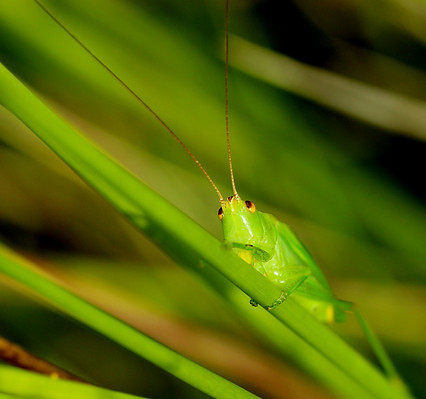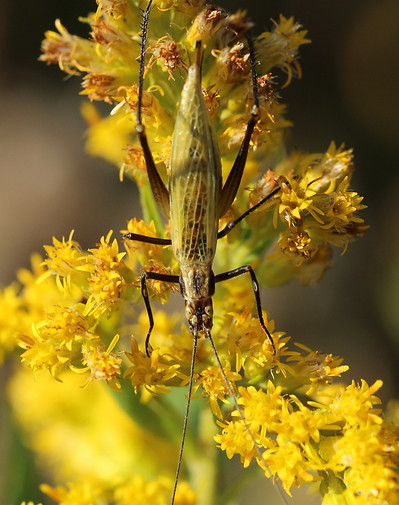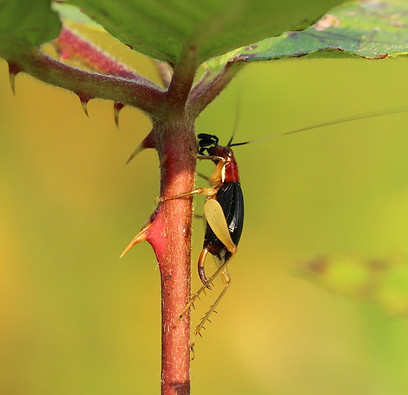Masters of Camouflage and Skillful Escape Artists

Ground and field crickets are dark and blend beautifully with soil and leaf litter. (Fall Field Cricket)

Our larger katydids are incredible leaf mimics. Unless you notice one moving, it’s unlikely you’ll even know it’s right in front of you. (Greater Angle-wing)


Meadow katydids resemble the stems and leaves of grasses and sedges. The slightly larger ones in the genus Orchelimum are very skilled at hugging the stems of thicker grasses and cattails, hiding on the opposite side of the stem from your current location. They will move around the stem as you change location, keeping the stem between your eyes and their bodies. (Gladiator Meadow Katydids)


Conehead katydids are long, relatively slender, and have pointed “cones” on the tips of their heads. They typically sing from thick-stemmed plants such as goldenrod, asters, and heavier grasses, appearing like leaves on the side of the stems. When threatened, they will drop headfirst into the lowest vegetation and become just another leaf or blade of grass. The females' long ovipositors may look like weapons, but these are just tools for depositing their eggs. Their methods of self-defense are simply hiding and escape.

Tree crickets, too, conceal themselves quite effectively. They are significantly smaller than katydids, which helps them hide. Like the other singing insects, their colors blend with the plants in which they live. Most are green, and they will often hide on the underside of leaves. (Snowy Tree Cricket)

Black-horned and Forbes’s Tree Crickets are typically found in goldenrod, and their yellowish wings and bodies combined with black legs and heads are a perfect match for goldenrod flowers.


Say’s Trigs (above left) are so small that their size alone makes them extremely difficult to locate. In addition, their coppery color helps them hide on branches and twigs of shrubs. But what about Handsome Trigs (above right)? These equally tiny crickets are bright red and black, so they should be quite obvious! No, not really. Handsome Trigs mature a little later than Say’s Trigs and persist well into autumn. Not only do they hide well in blackberry, they also match the reds of vines and shrubs as these plants take on their autumn coloration.
In addition to their camouflage, many of these insects sing from the underside of a leaf or even within a curled leaf.
They are harmless, and their defenses consist of hiding and escape.
Some, like ground and field crickets and meadow katydids, are very good jumpers. There are bush katydids and conehead katydids that fly well. Round-tipped Coneheads in particular will not hesitate to fly far enough away that it’s a challenge to ever find them again, especially as they would have plunged into the grasses upon landing.
These are the basics of when and where to look and listen. Subsequent pages will cover NE Ohio’s katydids, then NE Ohio’s crickets. I’ll also show you examples of mating, ovipositing, nymphs, and molting into adulthood. Are you interested in what they eat? I’ll have some photos of that as well.